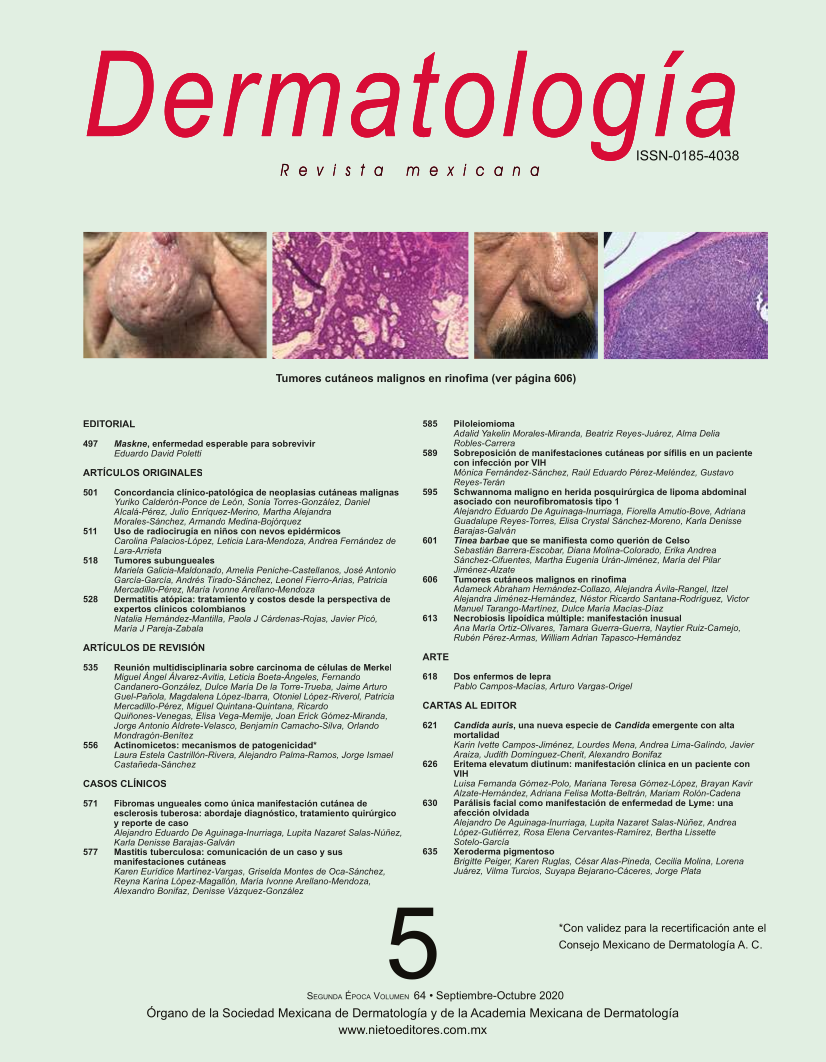Vitiligo-like rash. A rare side effect of antiPD1/antiPD-L1 therapy.
Dermatol Rev Mex. 2022; 66 (4): 564-570. https://doi.org/10.24245/dermatolrevmex.v66i4.7940
Yuriria Asbel Gálvez-Juárez,1 María Teresa de Jesús Vega-González,2 Ricardo Leal-León3
1 Residente de Dermatología, Hospital Central Dr. Ignacio Morones Prieto, San Luis Potosí, México.
2 Jefa del Servicio de Dermatología, Instituto Nacional de Cancerología, Ciudad de México.
3 Médico pasante del servicio social.
Resumen
ANTECEDENTES: El vitíligo inducido por la terapia dirigida antiPD1 y antiPDL1 se manifiesta incluso en el 10% de los casos, es más frecuente con pembrolizumab. Debe conocerse este efecto adverso debido a que puede afectar al apego al tratamiento por el efecto psicológico a los pacientes.
CASO CLÍNICO: Paciente masculino de 70 años de edad con una dermatosis diseminada a la cara, el cuello y zonas acrales, caracterizada por máculas acrómicas sin manchas en confetti, eritema perilesional y fenómeno de Koebner 10 meses después del inicio del tratamiento con pembrolizumab de melanoma etapa clínica IV.
CONCLUSIONES: La despigmentación que semeja vitíligo en los pacientes con terapia dirigida antiPD1-antiPDL1 tiene buen pronóstico, en ocasiones la repigmentación suele asociarse con recidiva de la neoplasia con la que está vinculado el tratamiento, específicamente en el caso de melanoma.
PALABRAS CLAVE: Nivolumab; pembrolizumab; atezolizumab; vitíligo; prurito.
Abstract
BACKGROUND: Vitiligo induced by antiPD1 and antiPDL1 targeted therapy occurs in up to 10% of cases, it is more common with pembrolizumab. This adverse effect should be known, because it can affect adherence to treatment due to the psychological impact on patients.
CLINICAL CASE: A 70-year-old male patient with a disseminated dermatosis to the face, neck, hands and feet, with achromic macules without confetti spots, perilesional erythema and Koebner’s phenomenon after 10 months of treatment with pembrolizumab of clinical stage IV melanoma.
CONCLUSIONS: Depigmentation that resembles vitiligo in patients with targeted antiPD1-antiPDL1 therapy has a good prognosis; repigmentation is sometimes associated with recurrence of the neoplasia to which the treatment is related, specifically in the case of melanoma.
KEYWORDS: Nivolumab; Pembrolizumab; Atezolizumab; Vitiligo; Pruritus.
Recibido: agosto 2021
Aceptado: septiembre 2021
Este artículo debe citarse como: Gálvez-Juárez YA, Vega-González MT, Leal-León R. Dermatosis similar a vitíligo. Un efecto adverso poco frecuente de la terapia antiPD1/antiPD-L1. Dermatol Rev Mex 2022; 66 (4): 564-570.

